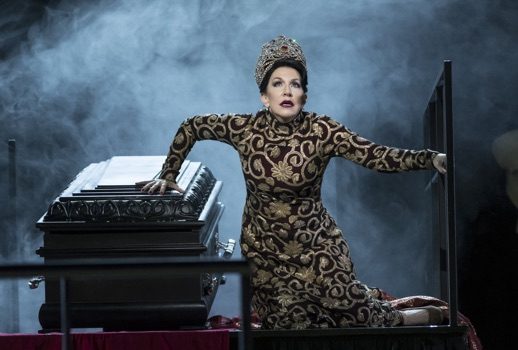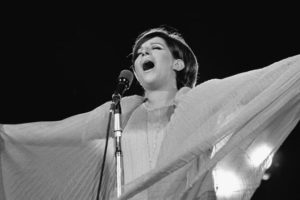

One from the vault
It’s a strange feeling, going to an opera that loads more people have heard than seen. To have seen Semiramide staged at the Royal Opera House before this season, you’d have to be over 120 years old, and a good many of the audience at tonight’s performance were younger than that.
In the meantime, London has seen only concert performances—one in 1969 with Joan Sutherland, and three in 1986 with the Joan Sutherland you can eat between meals without ruining your appetite, June Anderson.
My own experience of the work was fairly limited. I have a highlights disc of the DG recording—the one with Cheryl Studer on the cover in what we’ll euphemistically call “culturally problematic” styling—but with its efficiently uninspired music-making, that recording never really had much play. I know “Bel raggio lusinghier” pretty well, of course, and as I shuffled through the Royal Opera House foyer, past that odd display of Cio-Cio-San photos (Destinn, Turner, Schwarzkopf, Collier—you know, all the main ones) I found myself wondering if I was going to be in for a lot of filler and not much killer.
I’m not saying I was expecting a one-hit wonder, just that I thought it might be a similar experience to how I imagine going to see Oberon might be.
Well, more fool me, as many of you will already know, because this is a sweetshop of a score and although Joyce DiDonato fired off “Bel raggio” with pyrotechnic glee, that was only one of the evening’s many highlights. The two big duets between Semiramide and Arsace were particularly stunning, with “Serbami ognor” raising the pulse with its virtuosity and “Giorno d’orrore” stopping the breath with its beauty.
But wait, I’m getting ahead of myself, and it’s not as if “Semiramide—a better opera than this dude expected” is headline news anywhere other than in my ill-informed head. Let’s take it from the start.
The evening began with Antonio Pappano appearing in front of the curtain to say a few words about the early death of Dmitri Hvorostovsky, a reminder that every day real people really die and that’s why we need art. I imagine Pappano would have gone on to dedicate the performance to his memory, had the entire run not already been dedicated to Philip Gossett and Antonio Alberto Zedda, who prepared the edition used at this evening’s performance (for the 1990 Met production) and who have both already been claimed by 2017’s eager reaper.
Then, after an impressively swift dash from stage to pit on Pappano’s part, the overture crept into the room. How theatrically stealthy, the beginning of this opera. It’s not long before we’re into melody and grandeur, but those opening murmuring moments subtly hint at the private, internal demons of these very public-facing characters.
When those regular “name your unpopular opinion” threads circulate on social media, I am always tempted to say “I like staged overtures.” I’ve never understood why you’re supposed to hate them. I’d much rather be introduced to the world of the drama than stare at some curtains for five minutes.
That said, David Alden’s production made an excellent case for a tabs-in overture, because the first theatrical coup of many is that the curtains opened to reveal… blackness. Behind the tabs a black gauze, and we instantly get a prefiguring of the crucial role darkness plays in the plot of this opera. Eventually our eyes focus on a single figure—Balint Szabo’s excellent Oroe, who really made a case for this being an opera with five principals, not four—making his tortured way across the stage.
The black cloth flies out to reveal a second front cloth, a gorgeous patterned number based on middle-eastern tilework. This second cloth reappears a couple of times during the evening, and while it’s pretty enough always to be welcome, it’s usually in the service of one of opera’s more tedious pieces of practicality—that moment when the singers suddenly step onto the forestage, a cloth drops behind them, and everyone briefly steps out of the world of the opera because we’re all wondering what the big set change is and how long it’s going to take.
Paul Steinberg’s set is, in the purest sense, spectacular—it looks stunning and uses every kind of whistle and bell imaginable, with huge trucks and massive flying-pieces coming in and out—so it’s a shame that this piece of tired pragmatism should have made an appearance.
The first set configuration that we see is centred on a massive statue of a very human-looking Baal—the religious is very political in the world this production creates. There’s more than a whiff of director Alden’s famous “powerhouse” years at ENO in the 80s: humanity dwarfed by the sheer scale of the iconography it has created.
As the production goes on, this sense of scale is constantly reasserted: huge portraits of the ruling family slide in and out on bare walls, and rooms can recreate themselves around the characters as they sing. This isn’t an opera where sense of place is crucial—at least, not till the very end—so this fluidity of location helps keep the eye engaged rather than proving distracting.
There are a couple of unfortunate resonances, however: the basic set with the huge portraits looks so much like an art gallery that I half expected Anna Netrebko to wander in wearing a tour guide uniform and dream the plot of Il trovatore or whatever the holy hell that was. The huge portrait of the murdered Nino that looms over Assur’s mad scene is in a pose—right arm raised, index finger extended—so reminiscent of an umpire signaling the batsman is out that it’s probably for the best that this production isn’t planned for any more countries where cricket is played.
And when Nino’s ghost appears—an honest-to-goodness rising out of the coffin affair, not just a disembodied voice—his charcoal grey suit, red silk tie and sandy-silver hair make him look like nobody so much as… actually, never mind. Let’s just have one day that isn’t about That Guy.
But those gripes aside, the production looked, in all senses, epic and it was directed with a wonderfully reassuring expertise. It’s such an unexpected surprise, for example, to find a director who really knows what to do with a chorus, rather than dotting them around the stage in clumps and occasionally having them break out to do something distracting.
Every one of Alden’s stage pictures was meticulous and detailed, every idea fully examined and formed. One definition of good theatre is that wherever you look you should see something interesting. This has always been rare in even the finest opera productions, and all too often mistaken for being hyperactive and Zeffirellian and putting fucking jugglers everywhere. But Alden knows when a work needs movement and when it needs stillness, and how to tell a story, and how to fill a stage without either inertia or distraction.
If I wasn’t mad on some of the ideas (the flashbacks were a little muddying, and can we please have a moratorium on “look-at-this-child-with-a-toy-signifying-innocence?”) then that’s just a question of personal taste. In its conception and execution, this was very impressive work indeed.
And oh my god, the singing. I’ve become so accustomed to hearing DiDonato in music that places her voice under stress—all that Tough Mudder baroque coloratura—that I had forgotten how beautiful it can sound in repose. It’s simultaneously light and rich, radiant with purity but infused with a wisp of smoke. This monstrously difficult role seemed to hold no terrors for her at all, with even tone from a citrusy, biting bottom to a radiantly ringing top, and not a note out of place.
Touches of star-quality were everywhere, but always in the service of the drama, never self-indulgent. In addition to the aria and duets mentioned above, she made something particularly magical of “Io manco, io moro” at the close of the first act—despairing, white-toned, otherworldly, sinister.

If you’re tall, and have a darkly opulent coloratura mezzo voice, as Daniela Barcellona does, you’d better get used to being righteously angry in a military uniform, and nobody currently does it better. The voice itself isn’t particularly beautiful—although never unpleasant—but the ease with which she moulds it round the most fiendish music is thrilling.
The same applies to Lawrence Brownlee, last seen in London as Charlie Parker at the Hackney Empire, now making the journey a couple of miles west to remind everyone that he is unsurpassed at the day job. And just as I was thinking that even a tenor of this skill couldn’t make Idreno actually interesting, Alden and Brownlee made his act two showstopper something genuinely chilling: the moment when the self-proclaimed “nice guy’ becomes the abuser. Brownlee mauled and came close to attacking Jacquelyn Stucker’s Azema, all the while singing about love, before throwing her over his shoulder and forcibly carrying her off stage.
We saw in front of us the moment played out in Tinder conversations daily, where a would-be suitor turns from romantic pleading to anger that the woman isn’t loving him like he’s told her to.
Stucker is one to watch, by the way—she has a fine voice and was utterly committed to this production’s fascinating conception of her character. Shaven headed, and dressed in an opulent but immobilizing golden gown, a gilded strait-jacket with insanely long sleeves, she is carried on and off like a rug whenever she appears and shows signs that her status as a prize rather than a person has damaged her mental health—she spins, twitches, flinches. When Idreno claims her, he has his minions strip her of the gold dress and replace it with a wedding gown—but now she is veiled. She has regained her movement but lost her face.
Mirco Palazzi, replacing Michele Pertusi who was himself a replacement for Ildebrando d’Arcangelo, relished every moment of Assur’s villainy. Ian Wallace described a bass as “the one who comforts the soprano” and it must be hugely enjoyable to have the odd night where you get to be as evil as those other guys whose voices are about a third higher.
Palazzi snatched the opportunity. This production has Assur enter in a uniform that is more medals than jacket, waving a stick around, and legit the very first thing he does is kick someone on the floor. The voice, too, is perfect for the role—lithe and flexible rather than merely sonorous. His mad scene was genuinely exciting (and my word, wasn’t Verdi paying close attention?).
There was one moment of unfortunate near-comedy at the beginning: Palazzi has an unconscious tendency to bob his upper body around when singing coloratura—not the full Kermes, but not far off—which, combined with Brownlee’s unconscious tendency to rock onto tiptoes when singing higher notes, made the opening trio… well, let’s just say a little less ominous than it should have been.
But overall we’re talking about music-making, then, of the highest calibre, allied to a production which looks superb, is full of ideas, and executes them with the skill of an experienced master and a bunch of top-drawer singers and actors.
My initial misgivings weren’t, I think, entirely unjustified: with less careful handling from its musicians and its theatremakers Semiramide could easily, like all but a few unsinkable theatrical works, descend into an inert slog.
But tonight I looked at my watch at the interval and was astonished to find that nearly two hours had passed. And when an opera contracts time, you know you’ve had one of the good nights.
Photos: Bill Cooper/ROH
























Comments